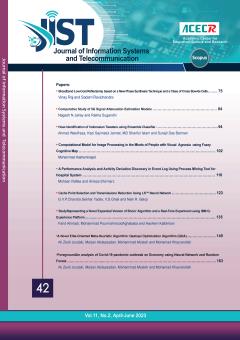-
-
List of Articles
-
Open Access Article
1 - Broadband Low-cost Reflectarray based on a New Phase Synthesis Technique and a Class of Cross Bow-Tie Cells
Mahmood Rafaei-Booket Mahdieh Bozorgi Seyed Mostafa Musavi -
Open Access Article
2 - Comparative Study of 5G Signal Attenuation Estimation Models
Md Anoarul Islam Manabendra Maiti Judhajit Sanyal Quazi Md Alfred -
Open Access Article
3 - Hoax Identification of Indonesian Tweeters using Ensemble Classifier
Gus Nanang Syaifuddiin Rizal Arifin Desriyanti Desriyanti Ghulam Asrofi Buntoro Zulkham Umar Rosyidin Ridwan Yudha Pratama Ali Selamat -
Open Access Article
4 - Computational Model for Image Processing in the Minds of People with Visual Agnosia using Fuzzy Cognitive Map
Elham Askari Sara Motamed -
Open Access Article
5 - Performance Analysis and Activity Deviation Discovery in Event Log Using Process Mining Tool for Hospital System
Shanmuga Sundari M Rudra Kalyan Nayak Vijaya Chandra Jadala Sai Kiran Pasupuleti -
Open Access Article
6 - Cache Point Selection and Transmissions Reduction using LSTM Neural Network
Malihe Bahekmat Mohammad Hossein Yaghmaee Moghaddam -
Open Access Article
7 - Representing a Novel Expanded Version of Shor’s Algorithm and a Real-Time Experiment using IBM Q-Experience Platform
Sepehr Goodarzi Afshin Rezakhani Mahdi Maleki -
Open Access Article
8 - A Novel Elite-Oriented Meta-Heuristic Algorithm: Qashqai Optimization Algorithm (QOA)
Mehdi Khadem Abbas Toloie Eshlaghy Kiamars Fathi Hafshejani -
Open Access Article
9 - An Analysis of Covid-19 Pandemic Outbreak on Economy using Neural Network and Random Forest
Md. Nahid Hasan Tanvir Ahmed Md. Ashik Md. Jahid Hasan Tahaziba Azmin Jia Uddin
-
The rights to this website are owned by the Raimag Press Management System.
Copyright © 2017-2025







